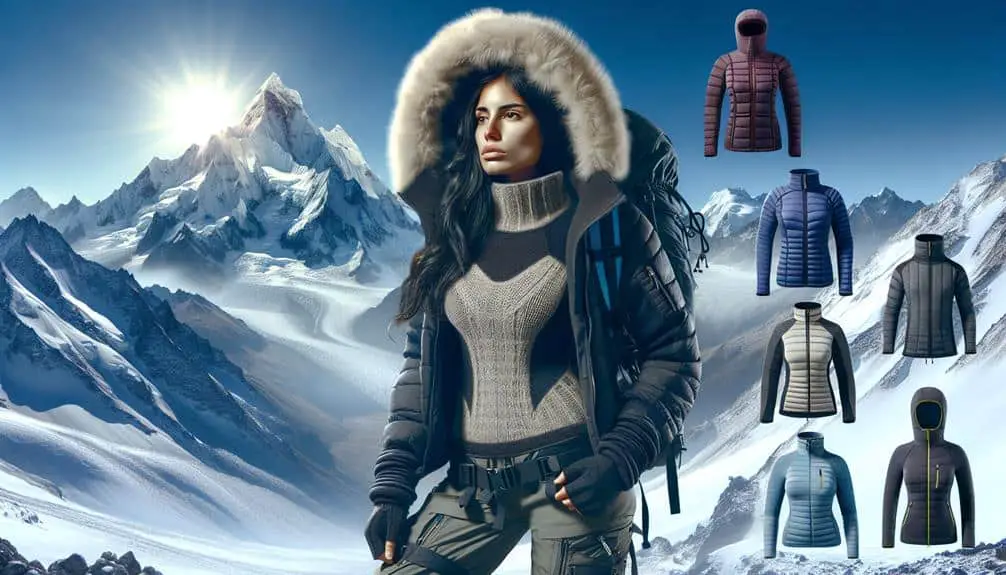When gearing up for cold-weather outdoor adventures, consider these top thermal base layers. Merino Wool Base Layers boast a micron count of 18 for softness and moisture absorption. Synthetic Blend Options offer durability and insulation. Compression Fit Choices aid muscle support and recovery. Lightweight Moisture Wicking Tops excel in moisture management. Thermal Undergarments for Layering regulate body temperature and provide insulation. Choose wisely to stay warm and dry in harsh conditions. More detailed insights on each type can enhance your outdoor experience.
Key Points
- Merino wool base layers with 18 micron count for superior softness and warmth.
- Synthetic blend options for durability and moisture-wicking in cold conditions.
- Compression fit choices for performance enhancement and muscle support.
- Lightweight moisture-wicking tops for comfort and quick-drying capabilities.
- Thermal undergarments for insulation and regulating body temperature during outdoor activities.
Merino Wool Base Layers
When selecting merino wool base layers for cold-weather outdoor activities, prioritize those with a micron count of 18. Merino wool with a micron count of 18 is finer and softer, making it more comfortable against your skin.
Concerning moisture management, merino wool excels at wicking moisture away from your body, keeping you dry and warm even in challenging conditions. This natural fiber can absorb up to 30% of its weight in moisture before feeling wet, making it an excellent choice for high-intensity activities in cold weather.
Moreover, merino wool base layers are known for their odor resistance properties. The natural structure of the wool fibers makes it difficult for odor-causing bacteria to thrive, keeping your base layer fresher for longer periods between washes. This is particularly beneficial during multi-day outdoor excursions where access to laundry facilities is limited.
Synthetic Blend Options
For peak performance in cold-weather outdoor activities, consider exploring synthetic blend options for your base layers. Synthetic blends offer a combination of performance durability and breathable insulation, making them ideal for intense outdoor pursuits in chilly conditions. These base layers are engineered to provide exceptional moisture-wicking properties, ensuring that sweat is efficiently drawn away from your skin to keep you dry and comfortable throughout your adventures.
The synthetic materials in these blends are often designed to be quick-drying, allowing you to stay warm even when faced with unexpected weather changes. Additionally, the blend of synthetic fibers enhances the overall durability of the base layer, ensuring that it can withstand the rigors of outdoor activities without compromising on performance.
When selecting a synthetic blend base layer, look for options that offer a good balance of insulation and breathability to regulate your body temperature effectively. By choosing a high-quality synthetic blend base layer, you can enjoy reliable warmth and comfort during your cold-weather excursions.
Compression Fit Choices
Consider prioritizing compression fit choices for your cold-weather outdoor activities to enhance performance and support muscle recovery. When selecting a compression base layer, guarantee a snug fit without restricting movement. Sizing tips suggest consulting the manufacturer's size guide for accurate measurements, typically based on waist and hip circumference. Material options vary from synthetic blends to merino wool, each offering unique benefits. Synthetic blends like polyester and spandex provide moisture-wicking properties and durability, ideal for intense activities. Merino wool excels in regulating body temperature and odor control.
The benefits of compression base layers include improved blood circulation, reducing muscle fatigue, and quicker recovery post-exercise. To maintain the compression properties, follow care instructions such as washing in cold water and avoiding fabric softeners to prevent deterioration. Rotate between multiple compression base layers to prolong their lifespan. By incorporating compression fit choices into your cold-weather gear, you can optimize your performance and comfort during outdoor pursuits.
Lightweight Moisture Wicking Tops
To maximize your performance and stay comfortable during cold-weather outdoor activities, prioritize incorporating lightweight moisture-wicking tops into your gear lineup. When selecting these tops, choose ones made from breathable fabric that allows moisture to escape, keeping you dry and warm. Seek out tops integrated with quick-drying technology, which speeds up the evaporation of sweat, preventing you from feeling clammy and chilled during breaks or when the activity intensity decreases.
Breathable fabrics like polyester blends or merino wool are excellent choices for moisture-wicking tops. These materials effectively pull sweat away from your skin to the outer surface of the fabric, where it can evaporate quickly. Additionally, quick-drying technology ensures that even in high-sweat situations, your top dries rapidly, reducing the risk of discomfort from wet clothing against your skin.
Thermal Undergarments for Layering
Thermal undergarments play a crucial role in providing insulation and regulating body temperature when layering for cold-weather outdoor activities. When selecting thermal undergarments, look for pieces made from insulating fabric that traps heat close to your body while remaining lightweight for ease of movement. Opt for materials like merino wool or synthetic blends that offer excellent warmth while wicking moisture away from the skin to keep you dry and comfortable.
For the best performance, consider layering with breathable fleece thermal undergarments. Fleece is known for its ability to provide warmth without adding bulk, making it an ideal choice for staying comfortable during high-intensity activities in the cold. Additionally, fleece fabrics are quick-drying, ensuring that even if you sweat, moisture is efficiently pulled away from your skin.
When selecting thermal undergarments for layering, prioritize fit and comfort to guarantee freedom of movement while maintaining the necessary warmth for cold-weather adventures. Look for seamless constructions and stretchy materials that allow for a full range of motion without compromising on insulation.
Frequently Asked Questions
Are Thermal Base Layers Suitable for All Types of Cold-Weather Outdoor Activities, or Are There Specific Activities Where They Are More Beneficial?
Thermal base layers excel in layering benefits for various cold-weather outdoor activities. They offer essential insulation for winter adventures, enhancing comfort and performance. Tailoring your base layer choice to specific activities optimizes their effectiveness in providing warmth and moisture management.
Can Thermal Base Layers Be Worn as Standalone Clothing, or Are They Meant to Be Worn as a Base Layer Under Additional Clothing?
You can think of thermal base layers like a sturdy foundation for a house. They work best as a base layer under additional clothing, offering ideal layering benefits for regulating body temperature during cold-weather outdoor activities.
What Is the Best Way to Care for and Wash Thermal Base Layers to Ensure Longevity and Effectiveness?
To guarantee longevity and effectiveness, proper care of thermal base layers is vital. Follow washing techniques carefully, using mild detergent, cold water, and air drying. Avoid fabric softeners and high heat. This maintenance routine will optimize performance and durability.
Are There Any Specific Skin Sensitivities or Allergies That Individuals Should Be Aware of When Choosing Between Merino Wool and Synthetic Blend Base Layers?
When choosing base layers, your skin sensitivities and allergies matter. Merino wool, though often touted as a wonder fabric, can still trigger reactions in some. Synthetic blends can offer a hypoallergenic alternative for those with sensitive skin.
Can Thermal Base Layers Help Regulate Body Temperature in Both Cold and Warm Weather Conditions, or Are They Specifically Designed for Cold Weather Use Only?
Thermal base layers excel at regulating body temperature year-round. They offer versatility for cold and warm conditions. Materials like merino wool and synthetic blends provide excellent breathability, ensuring comfort and performance in various outdoor activities.




